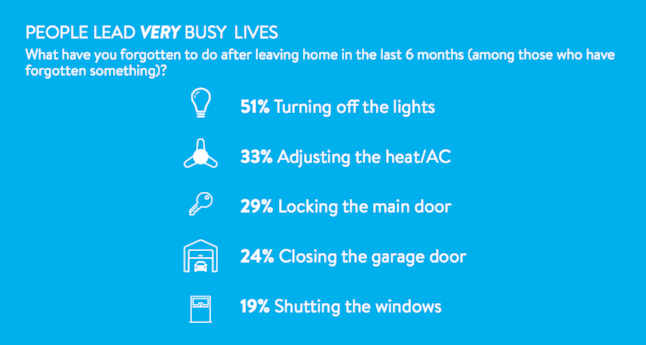Wink Smart Home Index: 71% of Americans wish they could monitor their home
We know that consumers are adopting connected products at a rapid rate, with analyst firm Gartner recently forecasting that 20.4 billion will be in use by 2020.
What we wanted to dive deeper on: why? Who is buying smart products and for what reasons? What do people wish their home could do but can’t currently? What is stopping more people from making their home smart?
Introducing Wink’s Smart Home Index.
We worked with the team at Harris Poll to survey 2,177 adults nationwide to get the answers to these questions. The full report - including the unexpected consumer behavior patterns we discovered - can be found here. The following are a few of the nuggets we uncovered:
PEOPLE FORGET TO DO THINGS THAT SMART PRODUCTS CAN FIX
Ever rush out of the house and get halfway to work or the airport only to question whether or not you locked the front door, closed the garage door, or turned off the lights? If so, you’re certainly not alone.
57% of Americans - that’s over 141 million - have forgotten to do a routine household task after leaving home in the last 6 months.
While forgetting to turn off a light isn’t a worst case scenario, leaving your door unlocked can yield very real - and serious - consequences. Wink gives you the power to take care of your home and the people in it no matter where you are.
PEOPLE CRAVE THE CONTROL SMART HOMES PROVIDE
We also found that nearly three quarters of Americans (71%) wish they could monitor their home when they’re away.
The rise in popularity of smart cameras like Canary and sensors like GoControl are proof positive that people want to stay connected to what’s happening back at the ranch.
RENTERS WANT TO GET IN ON THE ACTION TOO
A big misconception people have about the smart home is that it only makes sense if you own.
Tyler and Julia Waneka from San Francisco disagree. Longtime Wink users (and renters), they recently turned their new home into the landlord-friendly smart apartment of their dreams.
We asked renters what they thought about the smart home, and found 36% would pay more in rent to have smart products included as amenities in their home.
How much more? 5% annually. If you’re paying the median price for a one bedroom in Boston, that comes out to $1,680 more in rent per year.
THE PERCEIVED COST IS VASTLY INFLATED
Another common misconception about the smart home is that it is exorbitantly expensive.
Do you know what else you can buy for $20,000? One Honda Civic, 55 iRobot Roomba vacuum cleaners, or 5,479 grande lattes at Starbucks.
People think they have to spend a small fortune on dozens of products to fully reap the benefits of a smart home, but that’s not true. In fact, the average Wink user starts out with about 4 products, totaling approximately $175-200.
Our first and foremost tip to anyone interested in making their home smart is this: pick the smart products - whether that’s a few or a bunch - from the brands you trust and that make the most sense for your lifestyle and dwelling.
As Tyler Waneka told Curbed last month: ‘You just kind of get one thing at a time and then it starts making sense how you can wire them up...and make them play together.’
For more information on the Smart Home Index, email pr@wink.com.



